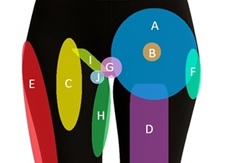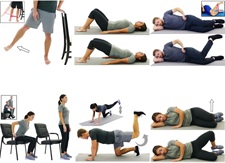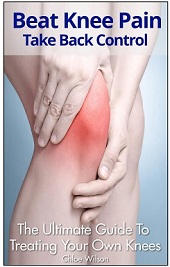- Home
- Hip Pain Diagnosis
- Hip Tendonitis
- Flexor Tendonitis
Hip Flexor Tendonitis
Written By: Chloe Wilson, BSc(Hons) Physiotherapy
Reviewed by: KPE Medical Review Board

Hip flexor tendonitis is a common cause of pain in the front of the hip and thigh.
It is typically an overuse injury which often affects active individuals, particularly if there is muscle tightness or weakness.
Front hip pain when running, going up stairs or bending the hip, particularly if you’ve been sitting for a while may be accompanied by a clicking or snapping in the hip with hip flexor tendinopathy.
Here we look at what hip flexor tendonitis is, the different types, common causes and symptoms, how it is diagnosed, the best treatment options and how to stop it from coming back.
What Is Hip Flexor Tendonitis?
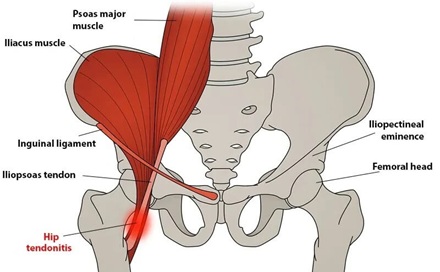
Hip flexor tendonitis is when there is inflammation or irritation of the tendons that bend and lift the hip. Tendons are the strong cords that connect the hip muscles to bone.
It typically occurs from overuse or repetitive strain, especially during activities that involve repeated hip flexion like running, kicking, or cycling.
Hip flexor tendonitis is also known as hip flexor tendinopathy or iliopsoas tendonitis. It is a common cause of hip flexor pain.
Types Of Hip Flexor Tendonitis
The hip flexors are a group of muscles that bring the thigh up towards the chest. Each of these muscles has a tendon that can become irritated or inflamed, leading to different types of tendonitis of the hip flexors:
- Iliopsoas Tendonitis: Iliopsoas is a group of three deep muscles made up of psoas major, psoas minor and iliacus. Iliopsoas tendonitis is the most common type of hip flexor tendonitis, causing front hip pain
- Rectus Femoris Tendonitis: one of the quadriceps muscles, rectus femoris, crosses the hip and the knee, and can contribute to hip flexor pain. Rectus femoris tendonitis usually presents with pain in top of thigh or near the hip bone
- Sartorius Tendonitis: Sartorius is the longest muscle in the body that runs down the front of the thigh, and assists in hip and knee movement. Sartorius tendonitis is less common but can cause pain along the front and inner thigh
Causes of Hip Flexor
Tendinopathy
Hip flexor tendinopathy is typically caused by:
- Repetitive Overuse: activities that require lots of repetitive hip flexion e.g. cycling, dancing, running and kicking sports e.g. soccer or martial arts
- Sudden Increases In Activity: a spike in intensity, frequency, or duration of exercise
- Muscle Tightness: tightness and inflexibility in the hip flexor muscles makes them more prone to tendonitis
- Muscle Imbalance: weakness in the glutes and core muscles places more loads on the hip flexors
- Prolonged Sitting: can cause tightness and weakness in the hip flexor complex e.g. office workers who sit all day
- Poor Posture Or Gait Mechanics: Can increase strain on the tendons over time, resulting in hip flexor tendonitis
Hip Flexor Tendonitis Symptoms
Typical symptoms of hip flexor tendonitis include:
- Pain at the front of the hip or groin, especially when lifting the leg e.g. stairs, walking uphill, tying shoelaces is the most common symptom of hip flexor tendonitis
- Tenderness over the front of the hip if you press on the affected tendon
- Stiffness or aching, especially after periods of rest or in the morning with reduced hip range of motion
- Dull, aching pain when resting and a sharp or burning pain with movement
- Weakness when trying to lift the knee or extend the leg behind you due to reduced muscle strength
- Clicking or snapping sensation in some cases
- Decreased stride length meaning you take smaller steps when you walk
- Low back pain due to the pelvis being pulled and rotated forwards
- Difficulty sleeping due to hip pain at night
Hip flexor tendonitis pain typically worsens with activity and improves with rest. It is just one possible cause of front hip pain.
Diagnosing Hip Flexor
Tendonitis
Hip flexor tendonitis diagnosis begins with a thorough clinical assessment. Because hip flexor pain can have several causes, getting an accurate diagnosis is essential to ensure proper treatment and recovery.
A healthcare professional, typically a physiotherapist or doctor, will assess your symptoms, movement patterns, and hip muscle function to pinpoint the exact source of the hip flexor pain.
Your clinician will usually begin by asking about:
- Onset Of Symptoms: when the hip flexor pain started, what activities trigger it
- Activity Levels: recent changes in training, intensity, or exercise habits
- Pain Behaviour: whether hip flexor pain worsens with certain movements like lifting the leg, walking uphill, or sitting for long periods
A hands-on physical assessment for suspected hip flexor tendonitis will likely include:
- Palpation: pressing over the front of the hip to check for tenderness along the iliopsoas or rectus femoris tendon
- Range Of Motion Tests: to see if hip flexion or extension is limited or painful. They will also check your lower back and knee movements to rule out other conditions
- Strength Testing: resisted hip flexion may reproduce pain or reveal weakness in the affected muscle
- Flexibility Tests: tightness in the hip flexors or surrounding muscles e.g. the quads or ITB, may be noted
- Functional Testing: movements such as walking, lunging, or squatting may highlight compensations or altered biomechanics
Pain reproduced with resisted hip flexion or passive hip extension is often a strong indicator of iliopsoas tendonitis.
Imaging Tests
In some cases, imaging may be used to confirm the diagnosis of hip flexor tendonitis or to rule out other conditions:
- Ultrasound: Can show tendon thickening, inflammation, or fluid in the iliopsoas bursa
- MRI: Offers a detailed view of soft tissue and may be used if symptoms persist despite treatment
- X-ray: Generally not helpful for tendonitis but may rule out bone-related conditions such as stress fractures or arthritis
Differential Diagnosis
Because hip flexor tendinopathy shares symptoms with other conditions, it is important to differentiate between possible causes of hip flexor pain:
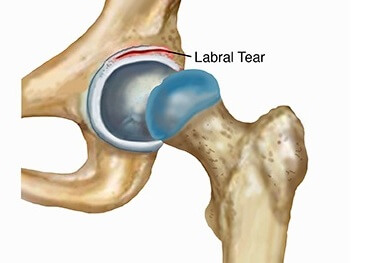
- Hip Labral Tear: Often causes deep groin pain, catching, or clicking
- Hip Flexor Strain: Tearing of one of the hip flexor muscles
- Femoroacetabular Impingement: Bony changes in the hip that limit movement and cause pinching or catching pain
- Hip Bursitis: Inflammation of one of the bursa e.g. iliopsoas bursitis or trochanteric bursitis can mimic hip tendonitis symptoms
- Inguinal or Femoral Hernia: Can cause groin pain during activity, coughing, or lifting.
- Snapping Hip Syndrome: A popping or clicking due to the iliopsoas tendon flicking over bony structures
- Lumbar Spine Referral: Nerve compression or irritation from the lower back can present as hip or groin pain
- Osteoarthritis of the Hip: Causes joint stiffness and aching, particularly after periods of rest
An accurate diagnosis of front hip pain is key to successful treatment, so if symptoms of hip flexor tendonitis are persistent, worsening, or interfering with daily life, it is worth seeking professional assessment early on.
#CommissionsEarned from Amazon on qualifying purchases
Hip Flexor Tendonitis Treatment
Early and effective hip flexor tendonitis treatment can make a big difference in recovery and typically involves:
1. Rest and Activity
Modification
The best place to start with hip flexor tendonitis treatment is to temporarily reduce or avoid activities that aggravate symptoms. Switch to low-impact alternatives like swimming or cycling (if pain-free).
2. Ice Therapy
Applying ice packs for 15–20 minutes several times a day can help reduce inflammation in the early stages of hip tendonitis. With more chronic cases of hip flexor tendinopathy, heat packs can help improve blood flow and aid healing
3. Medication
Short-term use of painkillers e.g. paracetamol or NSAIDs e.g. ibuprofen may reduce hip flexor pain and swelling.
4. Physical Therapy
Physical therapy is a key part of hip flexor tendonitis treatment. Hands-on techniques can help release tight muscles and improve mobility e.g. joint mobilisations or deep transverse friction massage
Shockwave therapy or therapeutic ultrasound may be used to stimulate tendon healing
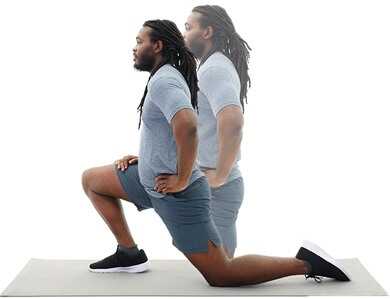
A tailored rehab program focusing on flexibility, strength, and correcting biomechanics is key.
Exercises for hip flexor tendonitis usually involve a combination of hip flexor stretches and hip strengthening exercises. Always avoid pain during exercise. Progress gradually under professional guidance.
5. Steroid Injections
In severe or persistent cases of hip flexor tendinopathy, corticosteroid injections may be considered, though they should be used cautiously as they can temporarily weaken the tendon. Injections should be used alongside other hip flexor tendonitis treatments.
6. Hip Flexor Surgery
Surgery for hip flexor tendinopathy is rare and usually only considered when conservative treatment has failed after several months, typically in chronic or severe cases of hip flexor pain.
If symptoms persist despite physiotherapy, injections, and activity modification, your specialist may consider hip flexor surgery, typically:
- Iliopsoas Tendon Release: This involves lengthening or partially releasing the tendon to reduce tension and irritation, often performed arthroscopically
- Bursectomy: If iliopsoas bursitis is present alongside hip tendonitis, the inflamed bursa may be surgically removed
Hip flexor surgery outcomes are generally positive when appropriate rehabilitation follows, but surgery is considered a last resort and not suitable for every patient. Recovery can take several months and usually involves a structured rehab program guided by a physiotherapist.
Recovery from Hip Flexor Tendonitis
Tendonitis of the hip flexors recovery varies depending on the severity and how early you start treatment. For most mild to moderate cases:
- Acute Hip Tendonitis Recovery: Usually improves within 3–8 weeks
- Chronic Hip Tendinopathy Recovery: May take 8–12 weeks or more, especially if it has been lingering
The key to successful hip flexor recovery is a structured rehab program that gradually reintroduces load without overstraining the damaged tendon.
Preventing Hip Flexor
Tendonitis
There are lots of things you can do to help reduce the risk of developing hip flexor tendinopathy:
- Warm up properly before sport or training
- Avoid sudden increases in training volume or intensity
- Strengthen glutes and core to reduce compensation and provide support
- Stretch the hip flexors regularly, especially if you sit a lot
- Cross-train to avoid overuse from repetitive activity
- Check your biomechanics - a gait analysis or running assessment can help identify movement issues
Final Summary
Hip flexor tendonitis is a common cause of front hip pain, particularly in active individuals or those with tight hip flexors. Caused by overuse, muscle imbalance or poor movement patterns, it leads to inflammation and pain in the front of the hip, thigh and groin.
The good news is that with early diagnosis, proper treatment, and targeted exercises, hip flexor tendinopathy is very treatable. Whether you are an athlete or spend long hours at a desk, making small adjustments to your routine can help you recover fully, and stay pain-free in the future.
You may also be interested in the following articles:
- Outer Hip Pain
- Inner Thigh Pain
- Pain In Top Of Thigh
- Hip Flexor Pain
- Hip Flexor Strain
- Hip Muscle Anatomy
- Hip Bursitis
- Snapping Hip Syndrome
- Hip Stretches
Related Articles
Hip Pain At Night
October 2nd, 2025
Hip Pain Diagnosis
September 16, 2025
Hip Strengthening
September 24, 2025
Medical & Scientific References
- Conservative Management Of Tendinopathies Around Hip. Muscles, Ligaments & Tendons Journal
- Current And Future Advances In Practice: Tendinopathies Of The Hip. Rheumatology Advances In Practice Journal
Last Updated: September 30th, 2025
Next Review Due: September 30th, 2027

